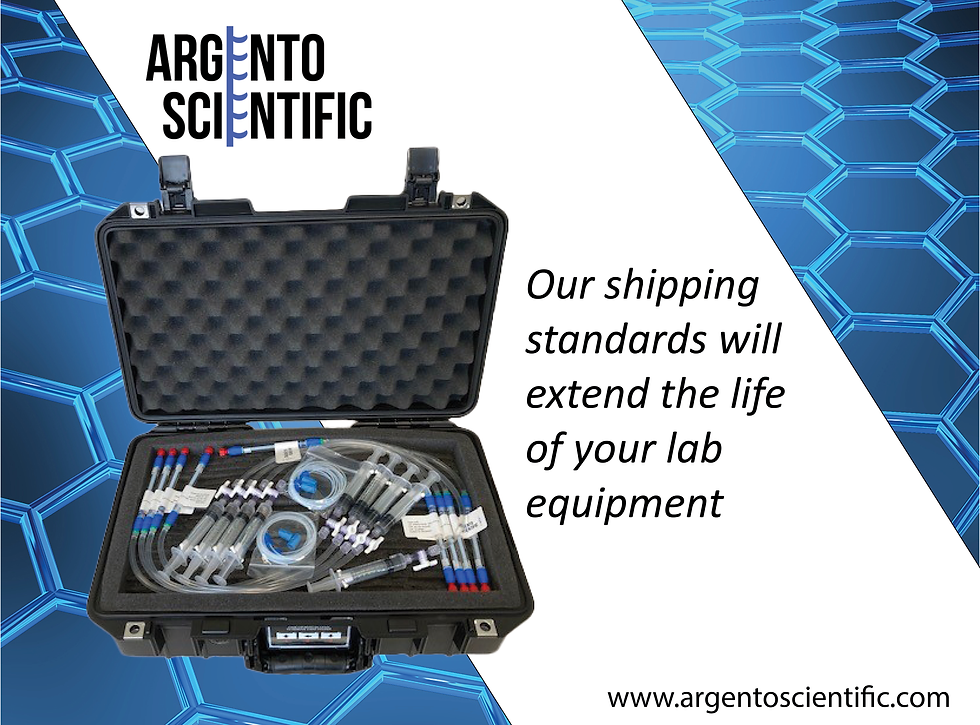Here be Dragons! Adventures in Shipping Packed Columns
- adrian6524
- Feb 28, 2023
- 4 min read
Updated: Feb 28, 2023

We started Argento Scientific 5 years ago to, among other things, take on the task of packing and testing protein chromatography columns for our customers. Our customers packed their own columns in-house. That meant the inconvenience of sourcing the materials and packing and testing the columns with lab equipment, equipment that was in high demand for other activities. These difficulties gave us a great opportunity to save our customers time and cost. The trouble, as we quickly learned, wasn’t just producing great columns in our lab, but delivering them ready to use.
Medieval mapmakers wrote the phrase “Here be Dragons” on uncharted regions of their maps, and when we started shipping our columns long distances it seemed like some of those dragons might still be out there. The dragon we encountered early on was bubbles, bubbles that appeared as a glittering sheen inside the glass. Chromatography relies on the even flow of analytes through the column and bubbles lodged in the packed bed disrupt that flow. Bubbles can also dislodge from the column and flow through the detector where they interfere with the optical reader. We found that packed columns could start their lives bubble free display bubbles days later. Bubbles could even disappear in the morning and reappear in the evening, like ghosts.

Bubbles form in columns because gasses dissolved in the shipping fluid come out of solution. Bubbles can emerge gradually or be driven abruptly out of solution by temperature and pressure changes in the column. Over time we developed steps to fight the bubbles:
Degassing – we thoroughly degas the shipping solvent before using it in columns
Flushing – we pump degassed shipping solvent through the packed columns to drive out dissolved gas
Equilibration – after packing the columns we let them sit for a period of time to see if mischief occurs. This approach varies depending on the resin as some resins hold on to gasses more stubbornly than others.
We undertook all of these precautions when packing the columns, and they did a wonderful job in eliminating bubbles. That is, all the bubbles disappeared until the columns shipped. Shipping seemed to create its own particular difficulties. Columns that stayed bubble free for days in the lab could suddenly fill up with bubbles after one day of shipping. We could see that this issue called for special attention.
Protein columns are a mixture of shipping solvent and soft agarose beads on the inside, and a sealed glass shell on the outside. The column makes its way in and out of buildings, trucks and airplanes during shipment. We realized that temperatures change during the process. Pressure inside the column can also change as the contents try to contract when cold or expand when warm. Both temperature and pressure affect the solubility of gas in liquid.
To solve the problem of bubbles that emerged during shipping we needed a way to let the packed bed contract or expand slightly, but in a controlled way. We accomplished this by developing a fluid-filled syringe with a spring-loaded plunger. We load the syringe with 20% ethanol, drawing back the plunger against the springs, and then we attach the syringe to one end of the column via a tube. A valve in the syringe makes this process easy by allowing the pressure to be briefly turned off. Throughout the column’s journey the syringe gently tries to push 20% ethanol into the column.

The syringes have worked well. In testing we could even see the plungers move almost imperceptibly up and down as we cycled the columns through different temperatures. We found that the syringes could hold the pressure for weeks. The syringes have mostly eradicated the appearance of bubbles inside the columns after shipping.
Mostly but not entirely – there was still a dragon or two lurking beyond our packing facility! This is to say that even with the implementation of de-gassing, syringes and other steps a small number of columns still showed up with bubbles. The trick however is that they don’t show up at our customers but at our own facility after a “test-ship”. Argento Scientific works from two facilities in New Jersey and Massachusetts. The columns are packed in New Jersey but they ship to customers from Massachusetts having made the cross-state journey first. In the rare cases where bubbles appear this gives us the chance to pack the columns again and tweak the packing parameters.
There is a final and perhaps obvious issue when it comes to shipping a product made of glass, breakage. This isn’t as much of a problem as you might think. The columns are made of glass but it's thick, borosilicate glass and it’s designed to withstand pressure. None the less we ship some of our columns in heavy-duty, customized Pelican cases. These are particularly convenient for customers who want to ship us back the spent columns for re-packing.

Between our spring-loaded syringes, the test-ship quality runs and using customized shipping containers we’ve slain the dragons that rear their heads during shipment. There are always more dragons to fight however, as any business knows!





Comments